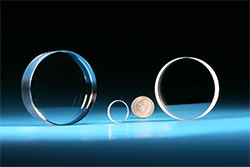Rayotek has been fabricating micro to large sapphire windows, sight glasses and flats for over 25 years. Although sapphire is often more costly than glass and other transparent materials, its exceptional properties can ultimately save money and reduce critical down time, often eliminating the need for PM periodic replacements.
| Synthetic sapphire is a single crystal form of corundum, aka, pure single crystal aluminum oxide, A12O3. The combination of its unique properties make sapphire a preferred material for extreme mechanical, chemical & optical applications. Unlike glass, sapphire cannot be molded. Sapphire can be grown into near net shapes such as tubes and rod, then ground and polished if necessary. |
| Aerospace |
Windows, ball bearings, sensors |
| Medical |
Dental tool tips, endoscopy, camera lens cover |
| Oil & Gas |
Sight window without housing, gauges, diffusion plates |
| Military |
Windows, viewports, sensors, range finders |
| Research |
Containment tubes, cuvettes, lenses |
| Semiconductor |
Plasma tubes, lamps, lasers |
| |
There are numerous sapphire growth methods & grades. Generally, the higher the grade the better the transmission in the UV and IR, and the less light scatter and lattice distortion. The best grades, in particular, UV grade will not solarize. |
| Verneuil |
Original & simplest growth method, lowest cost, excellent for mechanical applications & situations where optical clarity is not critical. Good for lower quality watch crystals & observation ports |
| EFG (Stepanov) |
Edge defined growth method (to be exact, Edge-Defined Film-Fed Growth) for near net growth of tubes & large sheets. Better quality than Verneuil, but not as pure & defect free as Kyropoulos or CZ. Excellent for most window applications including scanner windows & viewports and lower cost than Kyropoulos & HEM |
| Kyropoulos & CZ |
Excellent optical properties, ideal method for most optical applications except long exposure high UV & extreme power threshold requirements. Also preferred for high purity applications like semiconductor, LED fabrication & high purity chemistry |
| HEM |
The best quality sapphire, but difficult to acquire & considerably more costly compared to other grades. Quality compared to Kyropoulos usually not significant enough to justify cost for most applications. Best for extreme power & UV applications & for when zero fluorescence &/or high power threshold is required |
| C-Axis |
Also known as the "optical axis". The only orientation that has almost zero birefringence for signals parallel to the C-axis. Used for optimal optical, mechanical, thermal & electrical performance. In a rod or tube the typical C-axis orientation is along its length, in a window perpendicular to the face. |
| Random |
Parts are manufactured with no tracking of the crystal orientation. Lower cost & great for applications where orientation will not impact performance |
| Other |
90 Degree (to C-axis), M-Plane, A-Plane, R-Plane |
| |
Click for Orientation Definitions & Drawing |
| |
Thermal, physical/mechanical, optical, electrical & chemical |
| |
Click for Sapphire Properties Data Sheet |
| |
The overall transmission of sapphire is determined by purity. All quality sapphire materials transmit about the same in the visible wavelengths while higher purity creates better transmission in the UV and IR. For all optical materials, including sapphire, the thinner the material the deeper it transmits into the UV and IR |
| |
Click for Sapphire Optical & Thermal Properties Graph |
| |
Click for Transparent Materials Transmissions Curves Graph |
| Polished |
Clear. Has little to no distortion & light scattering (depending on level of polishing). Ideal for optical applications, high purity semiconductor, chemical & vacuum processing |
| Fine Ground |
Frosted. Ground surface roughness can be fine tuned for diffuser & low stiction applications. Tends to have micro-cracks that can trap water, gas & other impurities |
| As Grown |
Clear but not mechanically polished. Some optical distortion due to growth process but no micro cracks. Excellent for high vacuum systems such as plasma chambers & chemical processing where purity is critical but optical clarity is not |
| |
Click for Surface Finish Photos |
| |
The scratch-dig rating of surface quality is a qualitative rating based on comparing the actual surface to a scratch-dig standard. Pass or fail is somewhat subjective without clear dimensions to measure |
| 80-50 |
Commercial quality such as car windshield and commercial windows |
| 60-40 |
Good polish, good for commercial lenses and optics. Good for optics where light scatter is not a problem |
| 40-20 |
Superior polish, good for higher performance optics and lower powered lasers. Reduced light scatter over 60-40 |
| 20-10 |
High Precision polish, extreme optics & good laser power threshold for medium powered lasers. Very little light scatter |
| 10-5 |
Highest surface quality, highest laser power threshold and lowest vulnerability to solarization. Exceptional optics with near-zero light scatter |
| |
Click for Quality Scratch-Dig Definitions |
| |
One of the hardest materials available |
| |
Superior IR & UV transmission compared to other optical materials |
| |
Highly scratch & abradant resistant |
| |
Highly chemical resistant |
| |
Maximum temperature rating of almost 2000C |
| |
Excellent dielectric & loss tangent performance |
| |
Onsite engineers & master optician |
| |
25+ years of expertise in sapphire & exotic materials manufacturing |
| |
ISO 9001:2008 Certified |
| |
ITAR Registered |
| |
State-of-the-art manufacturing equipment & measurement capabilities |
| |
Cost saving overseas sourcing (for non-ITAR applications only) |
| |
US Manufacturing at Rayotek's 30,000 SqFt facility + partnerships in the U.S., China, Europe & Russia |
| |
Annealing |
| |
Bonding/Fusing |
| |
Coating |
| |
Fire Polishing |
| |
Grinding |
| |
Laser Engraving |
| |
Machining |
| |
Screen Printing |


